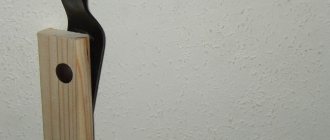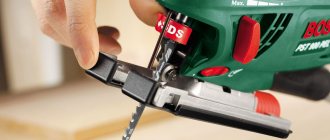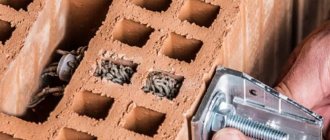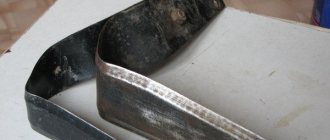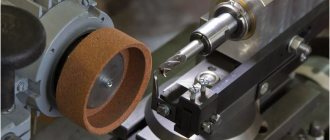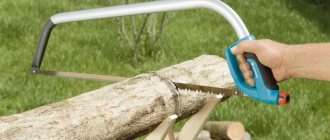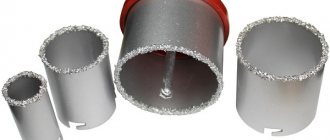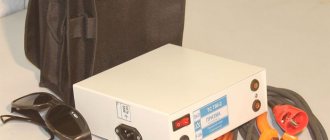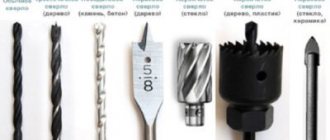The popularity of the Fokin flat cutter among Russian summer residents is growing every year.
The flat cutter is named after its creator, Vladimir Fokin. This tool for tillage is recognized as an invention and has received four RF Patents and, in addition, has been repeatedly noted at International exhibitions.
The work of the Fokin flat cutter is carried out in accordance with the main principle of natural agriculture - no-moldboard tillage , in which the structure of the soil does not change and the activity of beneficial microorganisms is not disrupted.
Working with this tool is much more convenient than using a traditional pitchfork or shovel: your joints and spine will only thank you for such a physiological load. The unique design of the Fokin flat cutter makes it a universal gardener's assistant and a complete replacement for various gardening tools.
The cutting element of the Fokin flat cutter is produced in two sizes: large and small.
It usually contains two sharp edges, but a modified version of the tool also has a third sharpened edge, making it easier for left-handed people to use. With the help of sharpened “toe” and “heel” and its flat surface, a wide variety of garden work is carried out.
How to use a Fokina flat cutter: loosening the soil
Loosening the soil with a Fokina flat cutter. First stage.
The vast majority of work with a Fokin flat cutter includes an operation such as loosening.
It is carried out in two stages. First, the cutting element is buried at a slight angle (almost vertically) at a certain distance and pulled towards itself, lightly pressing it against the soil. Then the handle is placed in the hands in the same way as a rake is usually held, the cutting element is buried flat (parallel to the top layer of soil) and the tool is pulled towards itself with a smooth movement.
Due to the fact that the blade and guide plane form a 90-degree angle, the tool moves easily in the soil without causing the unwanted effect of raking the soil.
Using a flat cutter you can loosen the soil to a depth of 15 centimeters. However, the effectiveness of such work is reduced on heavy clay soils, so on these types of soil it is preferable to use Strizh or Aist flat cutters.
Features of the flat cutter
Although the flat cutter looks simple, it can perform many functions. This makes it versatile. The tool has many advantages:
- For organic farming, you will not need to dig the soil, but only cultivate it with a flat cutter. This way you will save your time and effort. In addition, the soil layers do not turn over during processing, which preserves its structure and all microorganisms. Thanks to this, productivity increases.
- Even a pensioner will be able to work with a flat cutter without problems and extra effort. It's not difficult to do this.
- Thanks to the flat cutter, you can easily destroy weeds by turning them into fertilizer. When you constantly cultivate them, the roots rot in the soil.
As you can see, the benefits of the tool are quite great. With just one flat cutter you can perform about 30 types of work.
Note! The functions of the flat cutter include removing weeds, loosening the soil, hilling up beds, cutting grooves for sowing seeds, cleaning livestock buildings, raking hay, mowing grass, etc. At the same time, the work requires a minimum of effort.
But how exactly to work with a Fokin flat cutter? Let's find out.
Formation of ridges
The Fokina flat cutter does an excellent job of forming beds.
To carry out this operation, you need to stand on one side of it and position the blade of the tool so that the “toe” points to the side. Next, the cutting element is buried flat in the soil and they begin to level the soil surface on the opposite side.
Often, large clods of earth remain in the formed bed, which need to be broken up and leveled. In this case, the flat cutter is laid parallel to the bed without digging and makes a back-and-forth motion with it, like a rake.
Small weed
The ten-centimeter blade with a width of 1.8 cm makes the small weed the most compact among hand cultivators. Feature of the product: only one sidewall and end are sharpened.
The weed, like a small flat cutter, is used for weeding between rows. Thanks to its small size, it is capable of clearing narrow spaces and between closely planted plants with pinpoint precision.
The soil processed using flat cutters is saturated with oxygen, retains a loose structure, and does not lose moisture and nutrients. Beneficial insects and microorganisms remain in the soil, its fertility increases.
- Author: Inna Kiseleva
Loosening and removing weeds between rows
Loosening the soil with a Fokina flat cutter. Second phase.
If it is necessary to lime a young weed, then simply cut it at the level of the soil surface, placing the Fokin flat cutter in the flat position. To get rid of a weed with a more powerful root system, you should bury the tool 3-5 centimeters and pull it out of the soil with two or three sharp and strong movements.
For working with a Fokin flat cutter between plants in closely spaced rows in open ground, a tool with a long handle but a small cutting element is best suited, and in greenhouses and greenhouses it is more convenient to use a flat cutter with a shortened handle.
Moreover, the destruction of weeds even from the surface of a large garden bed takes only a couple of minutes, which allows you to carry out weeding every 3-4 days and quickly get rid of even such persistent and tenacious weeds as gooseberry or wheatgrass.
Big blanket
The cloth is designed for quick and easy weeding. A large product of this type differs from other hand cultivators by the presence of a long (22 cm) blade, which has a special shape and is smaller than the standard width (2 cm).
The design allows you to conveniently, quickly and efficiently weed large areas of land. The tool is used for working between rows of those garden crops that require a large distance from one plant to another (potatoes, sunflowers, pumpkin, corn).
Mowing weeds
To control weeds in wide areas, a Fokin flat cutter works in the same way as a scythe. Of course, it is not suitable for large areas, but you can treat a small area or hard-to-reach places that are difficult to reach with a regular scythe without any problems.
Before you start mowing, you should assemble the tool using the top hole on the cutting element for a person of average height and the bottom hole for a person of below average height.
After mowing, you can rake the grass into a pile and transfer it to the compost, holding the tool in your hands like a pitchfork.
A tool can only be appreciated if it is used correctly . Many gardeners, when purchasing it, underestimate it and return to the usual shovel and hoe. What's the matter?
general description
The inventor's goal was to make a device with which one can perform work in the garden with minimal labor costs. Additionally, the author also pursued a personal interest, which boiled down to physical limitations after a heart attack. The result is a multifunctional and easy-to-use garden tool.
So, let's see what a flat cutter looks like. Its design is similar to an L-shaped bracket. One part is made as a platform for fixing on a flat wooden handle using a pair of ordinary bolts and nuts. The second is made with three sharpened edges that require periodic sharpening.
This simple device can, to one degree or another, replace the main set of garden tools. These include, for example, shovels, hoes, rakes, and scythes. Let's look at why a flat cutter is needed. With its help, according to the inventor, you can perform up to 20 different actions in the garden, among which are:
- cultivating virgin soil and loosening the soil within 15 cm of the thickness of the fertile layer;
Source chistog.clan.su
- weed control (cutting off old roots and eliminating young growth);
- hilling of plants;
- collecting tops and mown grass into piles or sheaves;
- caring for the soil in the area of shrubs without causing injury to their root system;
- formation of holes and rows for crops, leveling the earthen surface.
The working part of the tool itself is not large. Therefore, using a long cutting is not practical here. The optimal size is considered to be 110-130 cm. To prevent a tall person from constantly bending over, you can increase the length to 160 cm.
Varieties
On trading floors, I often came across only two modifications of the Fokin flat cutter. The difference between them comes down to size, so their names are logical: large and small. The first is used for cultivating the soil, the second for caring for beds.
In fact, there are 6 original flat cutters for a summer cottage. The table provides brief information about each of them.
| Model | Tool Features |
| Big | The main purpose of the device is to prepare the site for sowing. The depth of coverage of the earth cover reaches 15 cm. This allows you to loosen the soil and hill up plants or tree crops. |
| Small | This flat cutter is convenient to use when weeding rows of small vegetable crops such as carrots, onions or beets. But convenience and speed are limited to light soil types. |
| Sturdy | This device is relevant for working in areas with clay soil and virgin soil. Here the working part of the flat cutter is wider and shorter compared to the classic versions. This makes working with heavy soil easier. |
| Powerful | Here the blade is made even wider. This design allows you to engage in hilling of various vegetable crops. |
| Large cloth | Garden tools are intended for weeding large areas. The depth of the fertile soil layer covered here reaches 3 cm. For this purpose, the working part of the manual flat cutter is made with a long and narrow blade. |
| Small cloth | The distinguishing feature here from its larger counterpart is the smaller width of the blade. This allows you to remove weeds between the rows of seedlings and fruits. It is also convenient to form holes and grooves. |
It is interesting that the Large Fokin Flat Cutter can be used both for its intended purpose and for solving other problems. For example, the tool can easily cope with carrying hay or mixing mortar. Like the Small analogue, the product can be attached to the handle as it is more convenient for a left-handed or right-handed person. By and large, virtually any of the tools can solve several problems at the same time. But many, like my neighbor, still prefer to replenish their gardening tools in bulk, so as not to think about restrictions. The low cost of small metal fixtures pays off in any case.
Differences between original devices and fakes
Speaking of payback. This statement is valid only if the flat cutters are of high quality. Since they look and are made relatively simply, counterfeit analogues are often found on trading platforms. And they can be distinguished by several criteria.
The main feature is metal. Original flat cutters are made of high quality structural steel. It itself is black, inexpensive and practical. Also, the edges are well sharpened and the product is a little springy.
Source alicdn.com
It is also worth noting the following:
- the distance between the holes for the clamps is 75 mm;
- the workpiece in the form of a plate after the formation of a flat cutter has 4 bends;
- The surface of the sample is slightly rough.
Fake samples are comparatively softer, with paint, without a protective coating against rust. They can be bent without much pressure. If the device is equipped with a handle, then it often turns out to be painted, which does not correspond to the original tools. Also, there most likely will not be an “F” engraving on the metal.
Among other things, you should pay attention to the packaging and accessories. If these are manual flat cutters without a handle, then the box is made in the shape of a triangle, there are also bolts with washers, nuts with anti-corrosion protection and a small brochure. It is made of glossy pages and compiled by the author V.V. Fokin. Plus, products are always accompanied by an official certificate of product compliance with the declared quality. The latter should not be printed on a regular printer.
Source prom.st
Basic mistakes when working with a flat cutter
Let's look at the main mistakes that are made when working with a flat cutter.
The main mistake is that, out of habit, we work inclined, bending the spine, thereby negating the main advantage of the tool . When working correctly with a flat cutter, only a slight tilt of the body is allowed. To achieve this position, you need to choose an option for attaching the flat cutter to the handle in proportion to your height.
The second mistake is that some gardeners place the flat cutter on a round handle.
If you pay attention, you will see that the mount seems to be twisted in relation to the blade at an angle of 45 degrees. Due to this, the flat cutter is lowered into the ground at an angle, easily cutting off the roots of plants in the soil. So, this angle of inclination is maintained automatically only when working with a flat cutter with a flat handle. If the handle is round, then the flat cutter rotates, thereby complicating your work.
And finally, it is necessary that the flat cutter be well sharpened. Working with a dull flat cutter will only create additional difficulties for yourself by creating calluses.
When purchasing a Fokina flat cutter, do not forget to make sure that what you are looking at is not a fake.
How to distinguish an original from a fake
The first thing to remember: drawings of a flat cutter are not distributed, which means it is impossible to make it yourself. Only family members of the inventor have a license to produce the instrument.
Other manufacturers produce flat-cutters that look similar in appearance, but they are inconvenient to work with. Sometimes low-quality steel is used, as a result of which the flat cutter quickly bends and even breaks.
The main differences between the original Fokin flat cutter and the fake:
- The metal part has a stamp in the form of a capital letter "F". A fake does not have such a mark.
- The color of the flat cutter itself is black. The original instrument is not painted in other colors.
- The original is slightly rough to the touch, the fake is most often smooth.
- The original flat cutter is sold already sharpened. Counterfeits are most often sold with a blunt edge.
- The original flat cutter is springy, but bends. The fake is either made of soft steel and bends like a rod, or hard and does not bend.
- This tool does not rust - it is made of stainless steel.
- The original flat cutter comes with bolts and nuts for attaching to the handle.
The last distinguishing feature is that the package will contain a brochure from the inventor entitled “To the Earth with Science.” This is a detailed, 64-page instruction manual for setting up and working with a flat cutter.
The cuttings are included only with a set of two flat cutters. Their length is 120 to 130 cm. They can also be purchased separately.
Tool assembly rules
A simple mechanism should be correctly adjusted before work to suit your height and physical capabilities. The effectiveness of the actions it performs depends on how the Fokin flat cutter is assembled. The length of the handle, the sharpness of the sharpening and the angle of inclination of the steel tip are important. If everything is assembled correctly, the blade does not get stuck in the ground, and the worker’s back is not overstrained.
What you should pay attention to when assembling the flat cutter:
- For right-handers, the steel tip should be turned with its sharp part to the right relative to the handle, for left-handers - to the left.
- A physically strong person can increase the load by attaching a metal attachment to the inside of the handle. Others should reduce the working area of the steel plane by attaching the tip to the outside of the wooden base. In the second case, the tool will lift less earth.
- Screw the blade at a slight angle towards you onto the handle. Try it in action. If the tool gets stuck in the ground, change the angle. Choose the one that's perfect for you. How best to set it up so that working with a flat cutter is easy is a matter of practice for each individual person.
A large flat cutter for a tall person can be attached in the direction of the handle. The main thing is that the summer resident does not bend over too much while working. Therefore, the wooden handle for all types of this tool must be long enough.
If necessary, you can use the Fokin flat cutter to perform other work in the garden or vegetable garden, using the instructions for use, which necessarily accompanies the original product in the package.
To assemble the tool, use a handle 30-40 cm long below your height.
